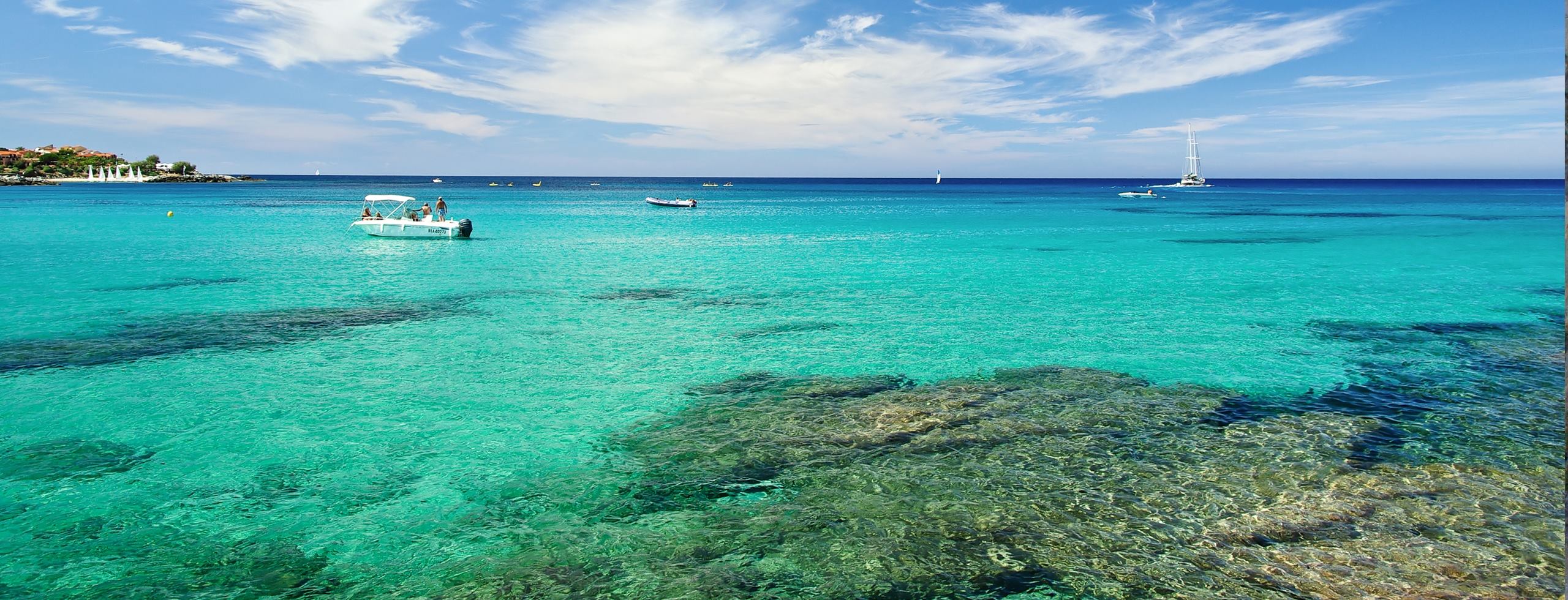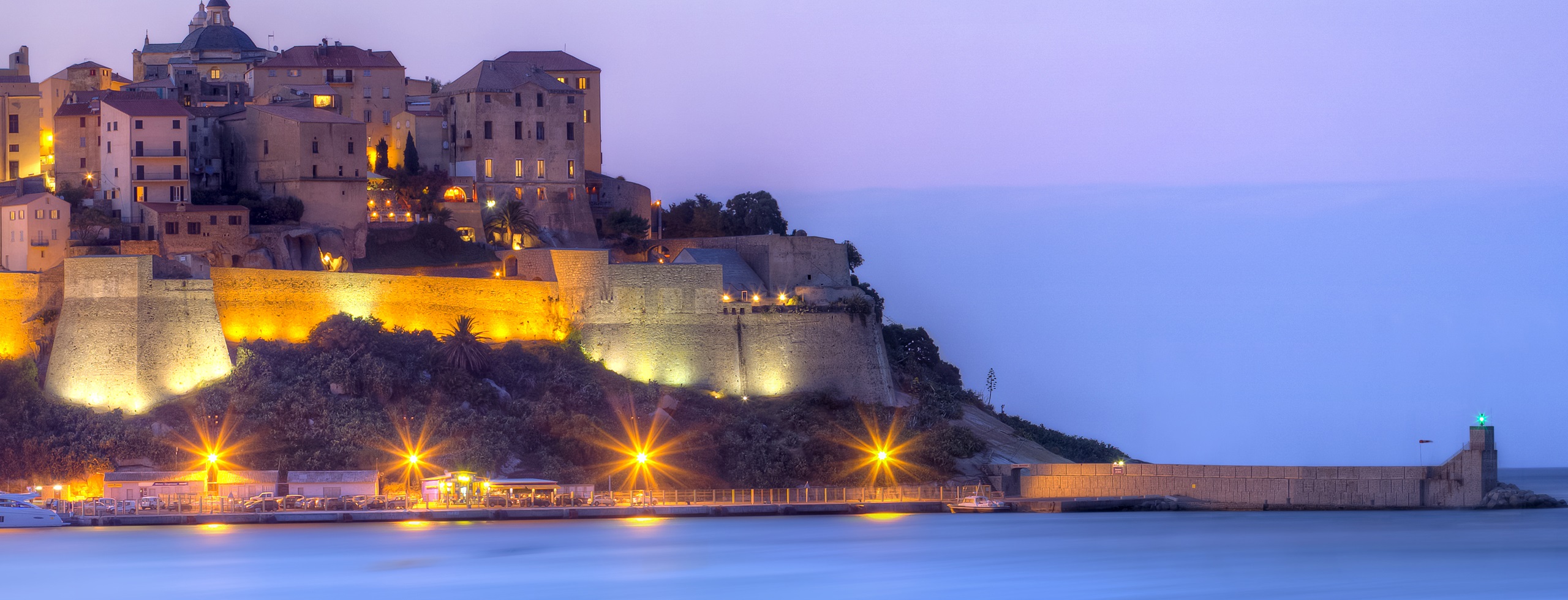Separated by only 7 miles/11 kms of the Strait of Bonifacio off the northern tip of the Italian island of Sardinia, it is possible to visit Corsica as a one-day excursion, although there are enough interesting and pleasurable things to see and to warrant a stay for a few days. With an area of 3,350 sq. miles/8,680 sq. kms – about the same as Crete or Puerto Rico – Corsica is basically an extension of the same granite formation that underlies Sardinia, but it is even more mountainous, and in fact 2/3 of its area is mountainous. Much of the natural terrain is covered with the low vegetation known as maquis; it has such a powerful fragrance that Corsica is sometimes known as “the scented island.” It never developed much in the way of industry, relying instead on its agricultural products such as cheese and wine; it also produces cork, but is most famous for its honey varieties. Tourism is also a major contributor to its economy.
Route 1: Southern Corsica
Although only some 115 miles /185 kms from north to south, Corsica’s rugged mountains and winding roads mean that a quick one-day tour hardly does justice to the island, so it is best to arrange two separate excursions. Ajaccio, the capital, is almost certainly on the top of everyone’s must-visit list; aside from being associated with the island’s famous native son Napoléon, it is the transportation hub of the island and offers the most selection in terms of restaurants, hotels, and shops. The city is actually quite attractive, situated as it is on the sea with its promenade, a lively town center, and various nearby beaches. It has a 16th century Cathedral of the Assumption and a massive 15th century citadel, but most of its historical buildings celebrate the famous French general, Napoléon Bonaparte. He was undeniably one of the world’s major historical figures and you might like to visit the house where he spent the first nine years of his life at 1 Rue Saint-Charles in Ajaccio.
Setting out from Ajaccio, head south about 25 miles/40 kms for Filitosa with its extraordinary carved menhirs or tall upright stones, dating from about 4000-3000 BC; these most likely relate to the same megalithic culture that produced Stonehenge and the great menhirs of Brittany. From there proceed another 28 miles/44 kms to the somewhat rugged village of Sartène and follow the signs another 4 miles/6 kms to Cauria and the Fontanaccia dolmen, an impressive burial chamber erected by the same people. Nearby are the alignments of menhirs at Stantari and Palaghju. You may not be especially interested in such prehistoric remains, but since you have come to this corner of the world, it is an excellent opportunity to see such ruins.
From here proceed south 30 miles/46 kms to the lovely and lively port town of Bonifacio, with its dominating grand citadel perched on the limestone cliffs. Pass through the gateway of the citadel and stroll through the old streets, as well as up and down the stairways, and in and out of the Church of Saint Dominique. Next, head northeast up the coast to the fabulous beaches of Palombaggia or San Ciprianu. From here go northwest through the mountains via Porto-Vecchio, Zonza, Aullène, and Petreto-Bicchisano to arrive again at Ajaccio. Even though this trip has covered only some 200 miles/320 kms, it does take a full day because of the mountainous terrain. We hope this trip has introduced you to some of the more interesting sites on this special island.
Route 2: Natural Corsica
If you enjoy exploring less developed, more natural environments then this route is for you. Start from Corte, a delightful small town at the very heart of Corsica’s mountainous terrain, with a citadel that is perched on a rocky promontory high above town. Despite its remote location, it is surprisingly cosmopolitan due to its brief history from 1755 to 1769 as the island’s capital, the presence of a university, and many hotels. To the south is the Restonica Valley with its river and gorges, and a drive of some 10 miles/15 kms leads to a parking lot at the Bergeries de Grotelle, from here you can walk to two small glacier lakes. To the west is the Tavignano Valley, which is the deepest gorge on the island; it is accessible only by a 2.5 hour walk, but many find it worth the effort.
A drive south of some 20 miles/32 kms brings you to Vizzavona. Although little more than a hamlet, it is a favorite place to set off from for hikes through the surrounding forest and to the English Cascades which are a series of waterfalls at the foot of Mt. Oro. A somewhat more ambitious excursion involves a drive of approximately 60miles/96 kms west to Porto, a popular beach town that also offers deep canyons known as the Spelunca Gorges that can be explored by foot. Also incredible are the Calanques de Piana which are red cliffs that rise out of the sea at this inlet – they can be seen either by driving on the road above the cliff or by boat from the water. The Scandola Nature Reserve, a UNESCO Natural World Heritage Site, is also worth a visit and can be accessed only by boat. Any one or two of these sites can be explored as a day excursion from Corte, but they all lie within the northern section of the Regional Natural Park that covers some 40 percent of Corsica.
As your natural exploration comes to an end, we recommend trying some traditional local dishes, like wild boar or chestnut polenta, at one of the many restaurants. You might also like to try a local aperitif called Cap Corse – a fortified red wine with quinine added to give it a bit of a bite. This makes for a fitting end to an exploration of beautiful Corsica.
It would seem natural that Corsica’s history is much the same as that of its larger neighbor, Sardinia, and to some extent it is, but there are some significant differences in their histories. The Nuragic people did not play a role here. The Carthaginians, Romans, and Germanic tribes took their turn, as well as occasional raids by Muslims of North Africa, and in 756 AD, Pepin King of the Franks handed over Corsica to the Roman Catholic Pope. Pisa, Genoa, and the Spanish Aragon sparred over Corsica; in 1347, the Genoese took over Corsica and ruled until 1729 when Corsicans started a revolution that finally formed an independent Corsican Republic in 1755.
The leader of the Corsican Republic at the time was Pasquale Paoli, but in 1769 the French took over Corsica and Paoli fled to England where he was taken up as an exotic celebrity by literary circles and even featured prominently in James Boswell’s Life of Johnson. Corsica’s most famous native son, Napoléon Bonaparte was also born in 1769; it is this Napoléon that became the famous French general. In 1789, during the French Revolution, Pasquale Paoli returned to Corsica, originally with the support of Napoléon, but in fact working on behalf of the British; in 1794 Paoli set up the Anglo-Corsican Kingdom and most Corsicans turned against him. In 1796 when the British lost interest in defending Corsica, they allowed the French to take it back. Paoli once more went off to England, where, with a pension granted by King George III, he took up his status as an expansive character until his death in 1807.
After the Germans defeated France in 1940, the island was effectively a German outpost, but when they left, because Italy deserted the war in September 1943, Corsica was turned into an American airbase. In recent decades some Corsicans have called for more autonomy, and some have even called for independence, but most Corsicans prefer to remain with France. With all of this in mind, Corsicans do strive to maintain their own sense of a distinctive culture, and above all the Corsican language that is more closely related to Italian than it is to French; this language is also spoken in northern Sardinia.
Visitors to Corsica will find very peaceful, hospitable people, especially considering that tourism plays such a large role in their economy. Ajaccio, the capital and main city, has several historical buildings, many of which are associated with Napoléon; despite what you might think of Napoléon, having come this far, you should take the time to visit these historic places. In addition to the main beaches along the coast, there is a Parc Naturel Régional that includes a UNESCO World Heritage Site sheltering endangered species such as wild sheep and red deer. Visitors should also consider an excursion to view the spectacular Calanche Cliffs, a reddish formation along the coast north of Ajaccio. In fact, much of Corsica’s appeal lies in its natural environment and wild life, from birds to salamanders to wild boars.



 View Map
View Map 

